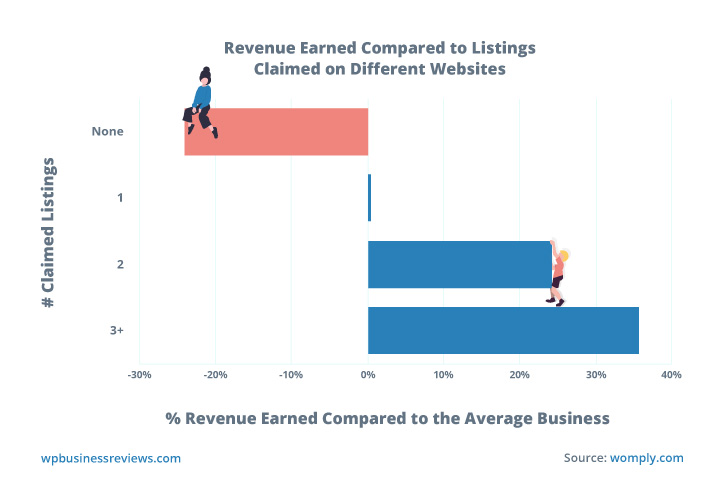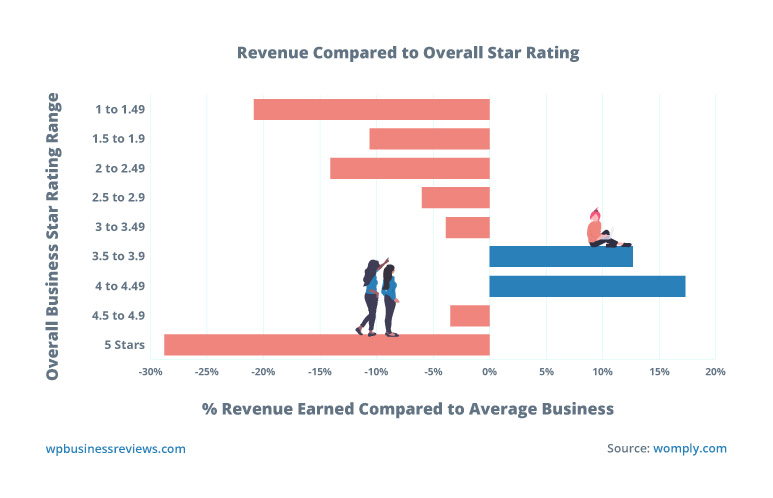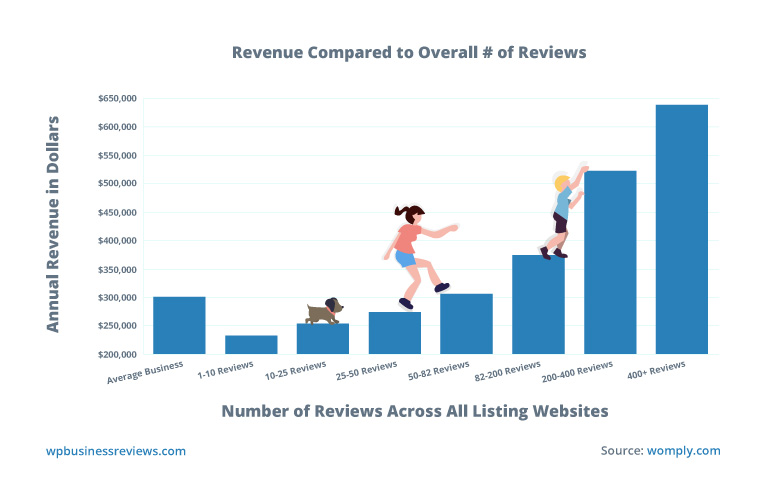Review management could be the difference between improving your bottom line and failing to meet it. Data from over 200,000 small businesses shows us that online reviews have a significant impact on revenue.
Taking care to sample only “small” businesses, Womply analyzed the impact of review management on revenue for businesses over a period of one year. In it, they found that claiming your listings prevents lost revenue. They also determined that the number of reviews and the responses to them from businesses have a direct impact on sales.
Here are six key pieces of data that use revenue as the key performance indicator to prove online reviews are a crucial piece of marketing strategies for small businesses.
1) Unclaimed listings are associated with lost revenue.
Review management starts with claiming your listings. There are a multitude of free listing websites online. The more you claim and pay attention to, the more your reviews are worth. The Womply study found:
- Google is the most important listing to claim: Failing to claim your Google listing correlates with an average loss of almost 25% in revenue, compared to less than 20% for Yelp and just over 15% for Facebook.
- Claim 3 or more sites: There is a clear pattern of increased revenue for more than three claimed listing websites. However, it’s important to remember that some sites have more weight than others (like Google).
- Not claiming listings results in less revenue: Small Businesses who haven’t claimed any listings on a review site make an average of $72,000 less in annual revenue than the average business.

Google is so influential primarily for its local search optimization benefits. It’s also one of the most-used platforms for reviews because of the widespread use of the Google Maps app. It’s not surprising that unclaimed Google listings result in the most lost revenue.
Think about your own small business, a client’s, or your home as an in-house marketer. How many listings have you claimed? Are you paying attention to Google? Are there any other platforms on which the business has collected reviews and are still unclaimed?
2) Review management and responses matter.
It takes more than just claiming your listings to see real results with your online reviews. Responding is a critical part of review management. (Although, simply claiming listings makes your page appear more managed than a lot of others.) Surprisingly, only 25% of small businesses respond to their reviews.
Ironically, not responding to reviews correlates with a 9% loss in revenue. On the other hand, Womply found that,
“Businesses that reply to more than 20% of their reviews earn 33% more revenue than average.”
If you aren’t responding to your reviews, try it. Seek out the best positive reviews and all the negative reviews. Leave a well-written response and make sure you don’t insult your customers.That is, of course, unless insulting is within your brand standards.
Use Your Reviews
Word of mouth is the cornerstone of every great marketing strategy. Sign up for our newsletter to get additional advice like this and more.

3) You need negative reviews to find the sweet spot for star ratings.
Most business owners are obsessed with getting as close as possible to a perfect star rating, but an average rating of five stars is not the best goal. You should aim lower. In fact, the average star ratings associated with the most revenue are between 3.5 and 4.5 stars. Here are a few other key facts from the Womply study:
- Businesses with perfect 5-star ratings make less revenue than those with 1-1.5 stars.
- Low ratings on Google and Trip Advisor have the most impact.
- Businesses whose reviews are 15-20% negative earn 13% more in annual revenue than businesses with 5-10% negative reviews.

So don’t obsess over gaining a perfect rating. You’re better off with genuine reviews, both positive and negative. Negative reviews have a lot of value.
A mix of reviews shows they’re more organic. It’s really hard for most people to believe anyone is perfect. An overall rating of five stars seems suspicious. Negative reviews also give you the chance to shine through your response. You can correct the situation and give the customer the satisfaction of knowing they’re heard. Others who see the response may be impressed and feel more positive about a potential experience with your business.
4) The total number of reviews is more important than your average star rating.
There is strength in numbers, even if those numbers bring your total star rating down. The total number of reviews about your business is even more important than the star rating. This is likely because more reviews means more people must visit your business. Numbers are a critical part of social proof. Womply found that:
- Businesses have an average of 82 reviews across review sites.
- More than 82 on all sites is associated with higher revenue.
- Less than 82 reviews on all sites is associated with lower revenue.
- Businesses with more than 200 reviews make more than double the revenue of an average business.

Be intentional about your review management strategy and make collecting new reviews a central part of it. If you aren’t acquiring new reviews, then you have nothing to manage. You’ll also end up with less reviews than your competitors.
5) Small businesses need recent reviews.
In the fast-paced world of small businesses in any industry, things can change fast. A customer’s experience six months ago might be completely different than it is now. Most of your potential customers are looking for recent information about your business. They want to know what your business is like right now. Womply’s data shows:
- Businesses with more than 9 recent (within 90 days) reviews make up to 52% more revenue than average.
- Businesses with 25 or more fresh reviews (within 90 days) make up to 105% more than the average business.
- Businesses with stale reviews (older than 90 days) earn up to 13% less than average.
Always make sure your strategy for review marketing includes ways to generate new (genuine) reviews. Don’t be afraid to ask regulars, happy customers, and anyone else who seems to have good honest feedback for you.
Review Management is Worth The Investment
Review management is one of the most important pieces of marketing. Bad reviews lose money and good reviews bring in more. The return is higher than many other forms of marketing.
It doesn’t take a lot of time to harness the benefits of review marketing. It depends on the size of your business and what your online reputation already looks like. If you find negative reviews on the first few pages of a search for your business, you’re losing revenue and it’s time to invest more into review management.
If you aren’t convinced by the data from 200,000 small businesses, calculate your own return on investment (ROI) for review marketing. You can also calculate potential revenue lost due to lack of review management. Use our formula for Review Marketing ROI to find both revenue lost and the revenue you have gained from your reviews.

